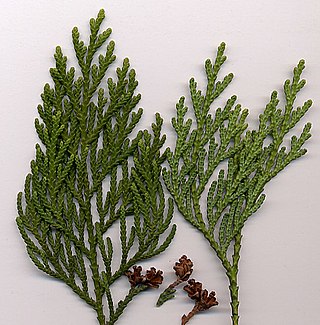
Thuja is a genus of coniferous tree or shrub in the Cupressaceae. There are five species in the genus, two native to North America and three native to eastern Asia. The genus is monophyletic and sister to Thujopsis. Members are commonly known as arborvitaes, thujas or cedars.

The Integrated Taxonomic Information System (ITIS) is an American partnership of federal agencies designed to provide consistent and reliable information on the taxonomy of biological species. ITIS was originally formed in 1996 as an interagency group within the US federal government, involving several US federal agencies, and has now become an international body, with Canadian and Mexican government agencies participating. The database draws from a large community of taxonomic experts. Primary content staff are housed at the Smithsonian National Museum of Natural History and IT services are provided by a US Geological Survey facility in Denver. The primary focus of ITIS is North American species, but many biological groups exist worldwide and ITIS collaborates with other agencies to increase its global coverage.

Thuja plicata is a large evergreen coniferous tree in the family Cupressaceae, native to the Pacific Northwest of North America. Its common name is western redcedar in the U.S. or western red cedar in the UK, and it is also called pacific red cedar, giant arborvitae, western arborvitae, just cedar, giant cedar, or shinglewood. It is not a true cedar of the genus Cedrus. T. plicata is the largest species in the genus Thuja, growing up to 70 metres (230 ft) tall and 7 metres (23 ft) in diameter. It mostly grows in areas that experience a mild climate with plentiful rainfall, although it is sometimes present in drier areas on sites where water is available year-round, such as wet valley bottoms and mountain streamsides. The species is shade-tolerant and able to establish in forest understories and is thus considered a climax species. It is a very long-lived tree, with some specimens reaching ages of well over 1,000 years.
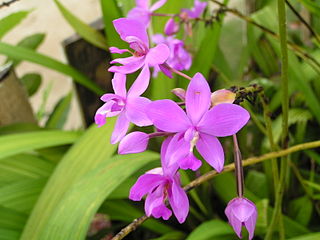
Spathoglottis, commonly known as purple orchids or 苞舌兰属 is a genus of about fifty species of orchids in the family Orchidaceae. They are evergreen terrestrial herbs with crowded pseudobulbs, a small number of leaves and medium-sized resupinate flowers on an upright flowering stem. The sepals and petals are all similar to each other and are white, yellow, pink or purple. Species of Spathoglottis are found from eastern and south-eastern Asia to Australia and some Pacific Islands.
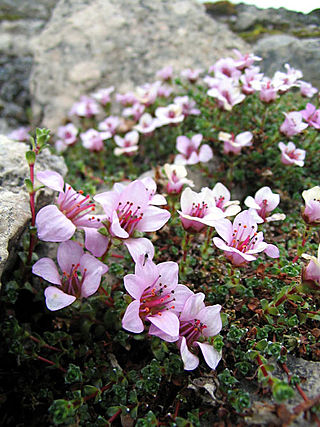
Saxifraga oppositifolia, the purple saxifrage or purple mountain saxifrage, is a species of plant that is very common in the high Arctic and also some high mountainous areas further south, including northern Britain, the Alps and the Rocky Mountains.

The Joinvilleaceae are a family of flowering plants with a single genus including four species. The APG II system, of 2003 assigns it to the order Poales in the clade commelinids in the monocots. The family consists of one genus with four currently accepted species, distributed from the Malay Peninsula to the Caroline Islands and high islands in the Pacific Ocean. It is evolutionarily significant as a relictual group closely related to grasses. They closely resemble large grass plants, in both general appearance and microanatomy, but possess fleshy fruits.
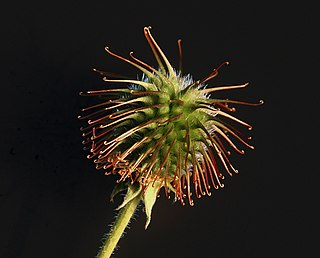
A bur is a seed or dry fruit or infructescence that has hooks or teeth. The main function of the bur is to spread the seeds of the bur plant, often through epizoochory. The hooks of the bur are used to latch onto fur or fabric, enabling the bur – which contain seeds – to be transported to another location for dispersal. Another use for the spines and hooks are physical protection against herbivores. Their ability to stick to animals and fabrics has shaped their reputation as bothersome.

Tiquilia plicata, the fanleaf crinklemat or fan-leaved tiquilia, is a perennial, subshrub-like plant of lower elevation deserts in the family Boraginaceae, the borages and forget-me-nots. It is found in the southwestern United States and northwestern Mexico, in the states of California, Nevada, Arizona, Sonora, and Baja California. It is a short, low-growing plant, seldom over 12 in tall.

Spathoglottis plicata, commonly known as the Philippine ground orchid, or large purple orchid is an evergreen, terrestrial plant with crowded pseudobulbs, three or four large, pleated leaves and up to forty resupinate, pink to purple flowers. It is found from tropical and subtropical Asia to Australia and the western Pacific including Tonga and Samoa.
Cullen plicatum, synonym Psoralea plicata, is a herb species in the genus Psoralea. It is native from northern Africa to north-west India and to South Africa.

Ahnfeltia plicata, the landlady's wig, is a species of red alga in the family Ahnfeltiaceae. It grows in northern parts of the Atlantic Ocean.
Microcodon is a genus of plants in the family Campanulaceae. It contains four known species, all endemic to the Cape Provinces of South Africa.

Cristaria plicata, the cockscomb pearl mussel, is a freshwater mussel, an aquatic bivalve mollusk in the family Unionidae.

Conophytum bilobum is a plant in the family Aizoaceae, native to southern South Africa. It blooms in autumn. It is scentless and grows to a height of 7 cm (2.8 in). The specific epithet bilobum comes from the two-lobed bodies these plants possess.
Opisthopatus herbertorum is a species of velvet worm in the Peripatopsidae family. The type locality is in South Africa. As originally described, this species is uniformly white with 17 pairs of legs. Subsequent phylogenetic results, however, cast doubt on this species delimitation based on morphology, indicating instead that O. herbertorum is a junior synonym of O. roseus.

Agalinis heterophylla is a species of flowering plant in the family Orobanchaceae known as prairie false foxglove. It is found in northern Mexico (Tamaulipas) and the southeastern and central United States.

Vernonia fasciculata, the smooth ironweed or common ironweed, or prairie ironweed is a species of perennial plant in the family Asteraceae. It is native to Manitoba in Canada and the north-central U.S.A.
Systena plicata is a species of flea beetle in the family Chrysomelidae. It can be found in the southeast and midwestern states of the United States and in Alachua, Columbia and Okaloosa counties in Florida.
Lejeunea mandonii, also known as Atlantic lejeunea is a species of liverwort from the Lejeuneaceae family.
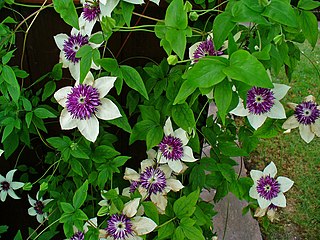
Clematis florida, the Asian virginsbower, or passion flower clematis, is a species of flowering plant in the family Ranunculaceae. It is native to southern China, and has been introduced to Korea and Japan. A perennial vine, in the wild it is typically found in shrublands and thickets, and alongside streams, at elevations around 1,700 m (5,600 ft). There are a number of cultivars commercially available, including 'Sieboldiana', Pistachio 'Evirida'PBR, and 'Plena'.















